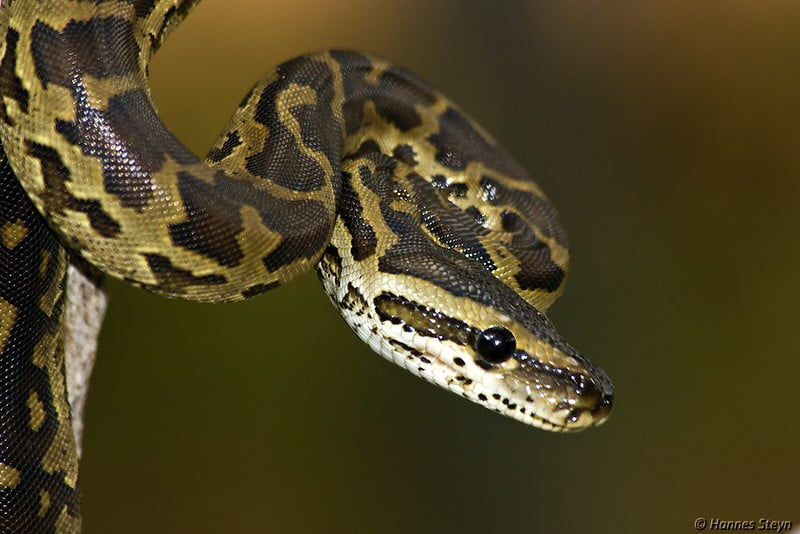Table of Contents
The Burmese Python is one of the largest snake species in the world, known for its impressive size and striking appearance. Native to Southeast Asia, these pythons are fascinating creatures with unique behaviors and adaptations. This guide explores the characteristics of the Burmese Python, shedding light on their intriguing traits and lifestyle.

1. Impressive Size and Length
Burmese Pythons are among the largest snakes in the world:
- Length: These pythons can grow up to 20 feet long, with some individuals even exceeding this length.
- Weight: They can weigh over 200 pounds, making them one of the heaviest snake species.
- Growth Rate: Young pythons grow rapidly, reaching their full size in just a few years.
2. Distinctive Appearance
The appearance of Burmese Pythons is both beautiful and distinctive:
- Coloration: They typically have a tan or light brown base color with dark brown blotches arranged in a symmetrical pattern.
- Pattern: Their pattern is reminiscent of puzzle pieces or intricate mosaics, providing excellent camouflage in their natural habitat.
- Albino Variants: Albino Burmese Pythons are also popular in the pet trade, known for their yellow and white coloration.
3. Natural Habitat
Burmese Pythons are native to Southeast Asia, where they inhabit a variety of environments:
- Range: They are found in countries like Myanmar, Thailand, Vietnam, and parts of China and Indonesia.
- Habitats: These pythons thrive in diverse habitats, including grasslands, marshes, swamps, and forests.
- Semi-Aquatic: They are semi-aquatic and often found near water sources such as rivers, streams, and lakes.
4. Feeding and Diet
Burmese Pythons are carnivorous and have a varied diet:
- Prey: They primarily feed on birds and mammals, including rodents, rabbits, and occasionally larger animals like deer.
- Hunting Method: They are ambush predators, relying on stealth and their powerful constricting ability to subdue prey.
- Infrequent Eaters: Due to their slow metabolism, they can go weeks or even months between meals.
5. Reproduction and Lifespan
The reproductive habits and lifespan of Burmese Pythons are notable:
- Breeding Season: Breeding typically occurs in the early spring, with females laying eggs several months later.
- Clutch Size: A female can lay between 12 to 36 eggs per clutch, which she incubates by coiling around them.
- Lifespan: In the wild, Burmese Pythons can live up to 20 years, while those in captivity often live longer, sometimes exceeding 25 years.
6. Behavior and Temperament
Understanding the behavior and temperament of Burmese Pythons is essential for those interested in these snakes:
- Docile Nature: Despite their size, Burmese Pythons are generally docile and can be quite tame, especially those bred in captivity.
- Activity: They are mostly nocturnal, becoming active at dusk and during the night.
- Solitary: These pythons are solitary creatures, coming together only during the breeding season.
7. Conservation Status
The conservation status of Burmese Pythons varies across their range:
- Wild Populations: In some areas, wild populations are threatened by habitat loss and hunting for their skin and meat.
- Invasive Species: In places like the Florida Everglades, Burmese Pythons are considered an invasive species, posing a threat to local wildlife.
- Conservation Efforts: Various conservation efforts are in place to protect native populations and manage invasive ones.
Conclusion on the Characteristics of the Burmese Python
Understanding the characteristics of the Burmese Python provides insight into their impressive size, distinctive appearance, diverse habitat, varied diet, reproductive habits, behavior, and conservation status. These fascinating creatures require specific care and consideration, whether in the wild or captivity. By learning about their unique traits, we can appreciate and respect these magnificent snakes. For more information on reptile care and conservation, visit the ASPCA and IUCN.
FAQs on the Characteristics of the Burmese Python
How large can Burmese Pythons grow?
Burmese Pythons can grow up to 20 feet in length and weigh over 200 pounds, making them one of the largest snake species in the world.
What do Burmese Pythons eat?
They primarily feed on birds and mammals, including rodents, rabbits, and occasionally larger animals like deer. They are ambush predators, relying on stealth and constriction to subdue their prey.
Where are Burmese Pythons native to?
Burmese Pythons are native to Southeast Asia, including countries like Myanmar, Thailand, Vietnam, and parts of China and Indonesia. They thrive in various habitats such as grasslands, marshes, swamps, and forests.
Are Burmese Pythons dangerous to humans?
While they are large and powerful, Burmese Pythons are generally docile, especially those bred in captivity. They can pose a risk if provoked or mishandled, but they are not typically aggressive towards humans.
How long do Burmese Pythons live?
In the wild, Burmese Pythons can live up to 20 years, while those in captivity often live longer, sometimes exceeding 25 years due to better care and absence of predators.
Are Burmese Pythons considered an invasive species?
Yes, in places like the Florida Everglades, Burmese Pythons are considered an invasive species, posing a threat to local wildlife and ecosystems. Conservation efforts are in place to manage their populations in these areas.











